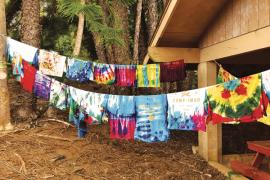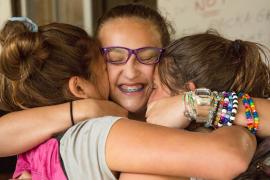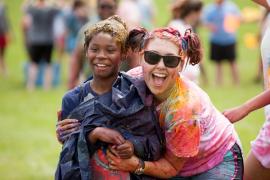"You learn about things that you do not learn about in school. It's actual reality and not sugar-coated. We learned how to work together. In school, they tell you to work together. I learned that when you work in a team, you have your own rights. If you have a good idea and another person has a good idea, you can actually accomplish what you want to do instead of it crashing."
— Mabel, Camp Fiver camper, age thirteen
Within the movement to connect children and nature, there is a growing sentiment that if children fail to develop attachments to natural spaces and places, society will ultimately fail to raise the next generation of stewards who will care for and protect their environment. Challenging youth to be leaders and stewards is an integral part of the camp experience, with many camps serving as living laboratories for the teaching of youth leadership using a variety of approaches.
When Camp Fiver (nicknamed "Fiver") enrolled in the American Camp Association's (ACA's) Camp 2 Grow program in 2009, the camp was looking for strategies to help integrate their leadershipand character-focused mission with an emphasis on teaching youth how to become environmental stewards. Two years later, Camp 2 Grow has become a component in Fiver's summer youth development approach to serving children from high risk New York City neighborhoods.
The successful integration of Camp 2 Grow in Camp Fiver's culture owes much to the easy agreement between the curriculum's objectives and the overarching Fiver approach. This approach is based on four cornerstones.
- Ten-Year Commitment: Youth development research strongly supports long-term interventions. Fiver commits to each child for a period of ten years, free of charge. This decade-long commitment ensures a continuity of relationships with Fiver children and their families.
- Smart Programming: Over ten years, Fiver participants progress through program stages designed to be developmentally appropriate. At each stage, guidance is provided to help participants gain self-confidence, broaden their perspective, and hone leadership skills. More focused programming addresses how to prepare for the journey through high school, the importance of giving back through community service, and college and career preparation.
- Focus on Character: Being a "FIVER" means: being a Friend, an Individual, a Valuable Team Player, an Environmentalist, and a Risk Taker. Participants learn why these character traits are important and how to develop and exhibit them in a positive and personal way. Each trait opens up new vocabularies participants may use to make sense of their life's successes and challenges.
- Evidenced-Based Practice: Fiver believes strongly in basing programs on proven methods that are easily articulated using qualitative and quantitative data. Ninety-five percent of participants have graduated high school, a figure well beyond the sixty percent average of their New York City peers. Eighty-eight percent of these graduates went on to college, many being the first in their family to achieve this milestone.
Camp 2 Grow Program Model
Camp 2 Grow is a leadership and environmental stewardship program developed by ACA through funding from Lilly Endowment Inc. to teach youth fundamental leadership knowledge and skills, and to provide them with a framework for implementing environmental stewardship applications in their camps, homes, or communities. Camp 2 Grow is designed to be integrated into a typical camp schedule and completed within a twoweek (or more) session. Based on national education standards, each lesson includes learning objectives and applications, stepby- step instructions for easy delivery, and an intentional scope and sequence that help youth develop essential leadership competencies. Camps customize Camp 2 Grow by selecting additional lessons most appropriate to achieve camp-specific goals.
Although research shows that youth typically benefit from the camp experience, particularly in building new skills and developing supportive relationships with peers and adults, little is known about the specific ways in which environmental stewardship attitudes and behaviors are enhanced by the camp experience. Previous national research into the developmental supports and opportunities provided by the camp experience suggests that some camps struggle to involve youth in experiences that promote youth involvement and decision making, indicating that camps could benefit from a structured youth leadership program designed to produce specific youth outcomes. In addition, many youth are not receiving authentic nature-based experiences. Within this environment of programming needs and nature deficits — and through a collaboration between ACA, National FFA, and Hooked on Nature — Camp 2 Grow was born. A positive youth development framework was used to connect leadership skill development to environmentally-based civic engagement (see Figure 1).
Researchers have also found that people with stronger emotional connections to nature demonstrate more environmentally responsible beliefs and behaviors. In other words, kids who learn to care about nature are motivated to take care of nature. Thus, the Camp 2 Grow program also sought to foster positive attitudes toward the environment (affinity toward nature) as precursors to stewardship-related behaviors.
Linking Leadership and Nature-Based Problem Solving
Fiver participated in the Camp 2 Grow program in 2009 and 2010, exposing campers to lessons in the core areas of leadership, character, teamwork, building relationships, taking risks and getting results, problem solving, and planning. Integrated into these lessons were customized environmental applications that provided youth with an opportunity to consider how lessons were related to specific environmental stewardship actions (see Table 1). Campers completed a "take-home" stewardship action plan, which allowed them to plan how they would solve nature-based problems in their homes, neighborhoods, or communities.
Fiver's Approach to Camp 2 Grow During the two years that Fiver implemented Camp 2 Grow, the camp learned much about the pros and cons of integrating a packaged curriculum into an existing LIT/CIT program. "Our first summer with Camp 2 Grow was a learning experience," remarked Fiver assistant camp director Chris Chavez, who participated in the initial "Train the Trainer" group of 2009. "Our biggest perceived challenge was to not do a disservice to our campers or be unfair to Camp 2 Grow's potential by simply interpreting it as a classroom-based curriculum. We knew our participating campers (thirteen- to fourteen-year-olds) would not react well to transforming a portion of their camp day into a period of a school day." Fiver settled on an approach that adapted the pedagogical strengths of Camp 2 Grow's pre-packed curriculum with the natural strengths afforded by the camp setting.
Camp 2 Grow lessons were given in varied settings and matched as closely as possible with the summer camp activities already part of a camper's daily schedule. Campers would talk of the importance of attitude while walking to the lake to have a more formal, sit-down note-taking session around a fire pit. Discussions on styles of leadership were held after field trips to a low ropes course or rock climbing wall in order to debrief actual demonstrations of leadership that took place in the moment. Conversations on teamwork, problem solving, and critical thinking were held following group community service projects both on and off camp grounds.
On paper, the approach reads well. In practice, finding ways to connect a firstyear curriculum to an established camp culture was a messy and time-consuming process. Coming up with settings and timing moments to introduce lessons required creativity and advanced planning to overcome the unexpected chores that would pop up during the camp day. Reflecting back on their experience, Fiver staff took away these three recommendations from their approach to Camp 2 Grow, generally applicable to any camp thinking of introducing Camp 2 Grow or any similarly developed program/curriculum to their camp setting:
1. The program or curriculum framework is a starting point.
A fully developed curriculum like Camp 2 Grow is similar to a prism. It can exist just fine on its own. But it is only when a prism is manipulated with intention that it turns from a piece of pleasant looking glass to a colorful educational tool that illustrates more about the world around us. A curriculum functions in the same way. It has constraints just like any tool would, but these constraints should be creatively developed in a way that best jives with your camp culture. Used in this way, a curriculum becomes more than a black and white collection of written lessons, transparencies, and activity suggestions.
2. Use experienced staff who have time for advanced preparation.
Research on youth development and an understanding of the transferable elements making up pedagogical best practices make up the foundation of the Camp 2 Grow curriculum. By no means is it a typical camp activity plan. A staff person who implements such a curriculum has the same job description as a translator; they must strike the right balance between what is being said by the curriculum and what is going to be understood by the campers who may be accustomed to a different way of doing things, or who are expecting something a bit less structured from their summertime activities. Ideally, staff involved in the implementation process should be fluent in two languages: the language of their camp's culture and the language employed by the curriculum. Staff responsible for curriculum implementation should be motivated for the challenge. Their mantra needs to be: "Prepare. Prepare. Prepare."
3. Push through growing pains.
Camp Fiver director Mary Dinski remembers that "the biggest concern when signing up for Camp 2 Grow was the potential for it to clash with pre-existing programs." First year reception of the curriculum was indeed lukewarm. Camp 2 Grow based discussions, however subtly introduced, were still a bit too structured for a camper's summer schedule. Having a strong sense of support from Camp 2 Grow staff, and seeing the improvements made to the curriculum from 2009 to 2010, Fiver chose to stick with the program. The start of the second year brought more success. Participating campers knew what to expect from watching their older counterparts, and secondyear program participants had the opportunity to appreciate the very real link between curriculum lessons and their experiences away from camp during the intervening school year.
Programming Based on Evidence
Fiver has a history of strong internal and external program evaluations and research efforts. This commitment to developing programs based on evidence fit well within Camp 2 Grow, where a solid program evaluation model has been integrated into the program. Data were collected from campers using end-of-camp surveys and camper journals. Surveys were also collected from staff and camper parents. Nationally, the results of the Camp 2 Grow program evaluation found that campers learned independence, empowerment, citizenship, and became more emotionally connected to nature and likely to engage in nature stewardship as a result of participating in the program. Youth expressed that through Camp 2 Grow, they developed techniques for working with others, enhanced their responsibility, and learned traits necessary to be an effective leader. Not surprisingly, youth who received the greatest benefits from Camp 2 Grow were those campers who were in leadership training programs and had a direct opportunity to apply what they learned.
At Camp Fiver, application opportunities were easily connected to the curriculum principles of Camp 2 Grow once the commitment was made to identify them in Fiver's pre-existing culture. Oliver Cano, Fiver's 2010 Camp 2 Grow implementer, had the following reflection on his summer experience with Fiver campers in the Camp 2 Grow program:
What I like about Camp 2 Grow is how compatible it is with Fiver's own character development program. I was able to place Camp 2 Grow in tandem with Fiver's own values and have them work to promote each other. If taken seriously and pushed, then the community engagement aspect [post-camp] could be really powerful.
Camp will always be a powerful setting for teaching youth about leadership and stewardship. In fact, organizations such as Teach for America, which places young professionals in teaching positions at schools in low income communities across the US, views camp as a producer of effective leaders (Teach for America, 2010). Opportunities to learn and practice leadership are engrained in the camp experience, yet at some camps these opportunities are presented to campers in subtle ways to avoid the perception that camp is too much like school. As camps seek to become both ideal settings for learning and intentional in the production of positive youth outcomes, many camps are seeking structured curricula and strategies for teaching and nature-based problem solving. These camps are finding that the need to explicitly label leadership, model leadership, and provide opportunities for youth to practice leadership are critical in preparing youth to become active as leaders in their homes and communities after camp is over. The Camp 2 Grow program, through integration by camps such as Camp Fiver, has proven to be a successful approach.
Visit www.ACAcamps.org/camp2grow/ for more information about Camp 2 Grow and to access a program grant application. For more information on the Fiver Children's Foundation, please visit www. fiver.org. All queries are welcome and may be addressed to the director of marketing and development, Christa McCarthy- Miller, at [email protected].
| Camp Fiver Camp Fiver is one of the summer programs organized by the Fiver Children’s Foundation, a year-round youth development organization making a ten-year commitment to each of 500 participants ages eight to eighteen. Approximately 85 percent of the children and families live in New York City, with the majority centralized in the neighborhoods of Fiver’s community partners: Mott Haven, East Harlem, Harlem, Jackson Heights, Jamaica, East Elmhurst, Bushwick, Brownsville, East New York, Sunset Park, and East Flatbush. The remaining participants live in rural Madison County within thirty miles of Fiver’s summer camp in Poolville, New York. Program participants are 41 percent Hispanic or Latino, 34 percent African-American, 15 percent Caucasian, 8 percent Multi-Racial, and 2 percent Asian. Over 40 percent live in single-parent homes and an additional 8 percent reside with other relatives or foster parents. All youth recruited into Fiver programs come from families eligible for the federal free and reduced lunch program. |
Reference
Teach for America. (2010). Retrieved from www. teachforamerica.org/index.htm
Barry A. Garst, Ph.D., is director of program development and research application for the American Camp Association and adjunct faculty at Virginia Tech. He can be contacted at [email protected].
Christopher Chavez is a program supervisor of the Fiver Children's Foundation and a 2010 regional trainer for the Camp 2 Grow program. E-mails are welcome at [email protected].
Originally published in the November/December 2010 Camping Magazine.



